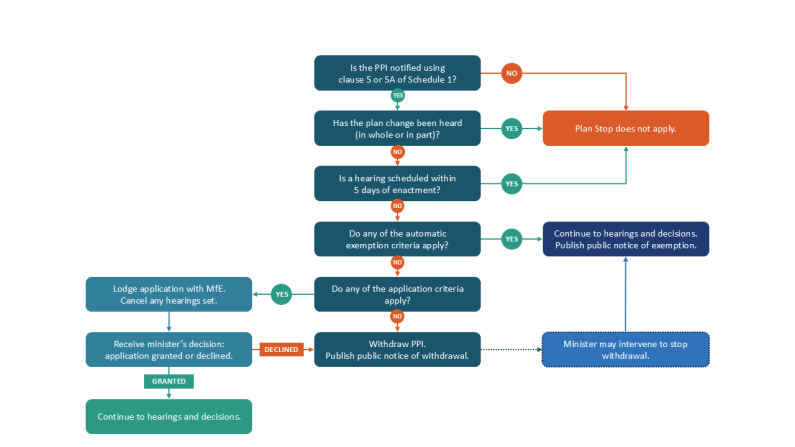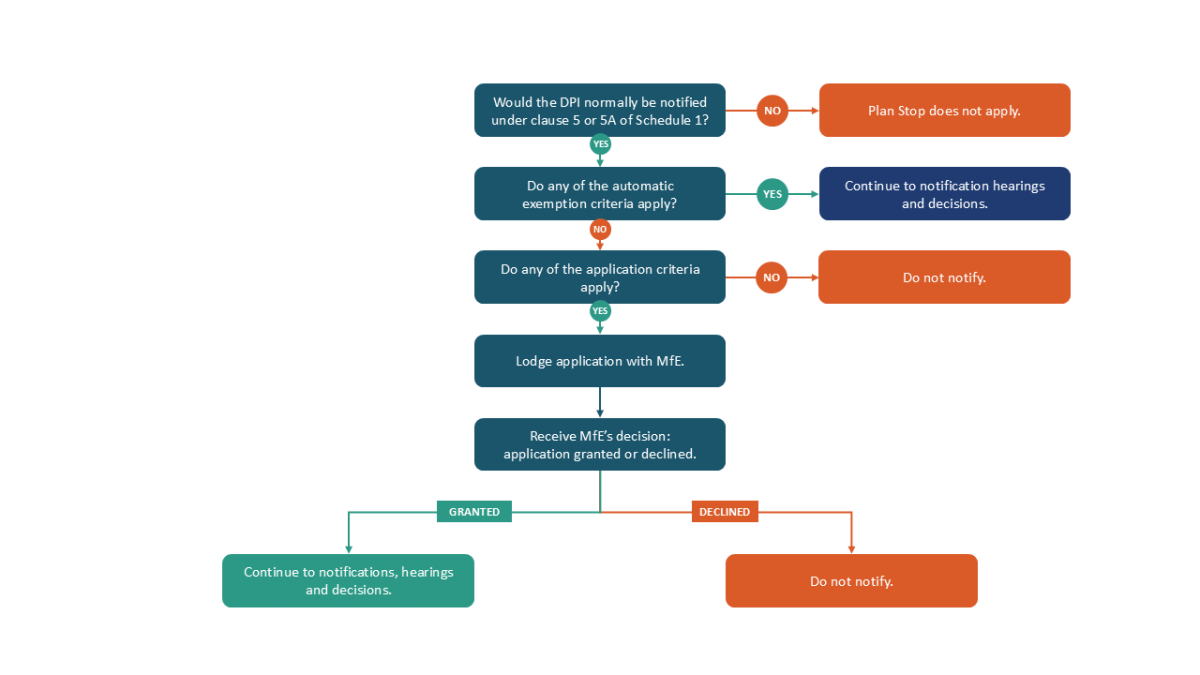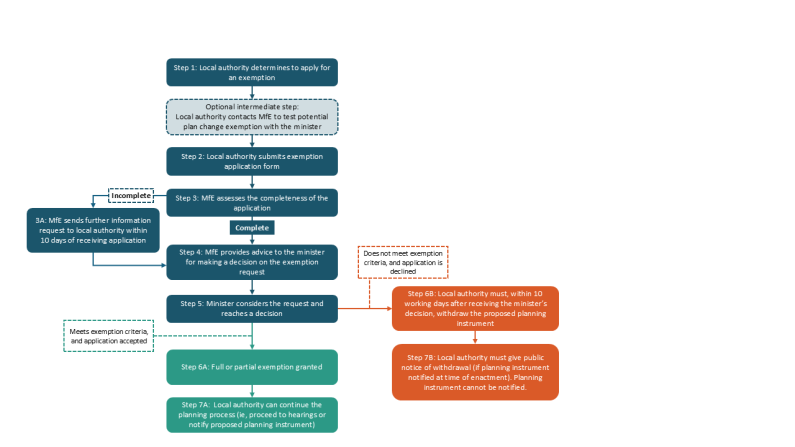Understanding Plan Stop
The Resource Management (Consenting and Other System Changes) Amendment Act 2025 brought in changes to pause councils’ work on review and change of their RMA plans.
The Resource Management (Consenting and Other System Changes) Amendment Act 2025 brought in changes to pause councils’ work on review and change of their RMA plans.
The intention is to ensure that local authorities do not expend resources unnecessarily by stopping parts of the plan-making process between the time when the Act comes into force and when legislation to replace the RMA comes into force. This policy intends to achieve greater efficiency for local authorities in view of the changes expected to be in force by the end of 2027.
The policy affects:
Where a proposed planning instrument has already been notified and heard (in whole or in part), the Plan Stop will not apply.
Where the proposed planning instrument has been notified but not been heard (or has a hearing set to begin more than five days after commencement of the Act), the instrument must be withdrawn unless an exemption applies.
After commencement, no new planning instruments may be notified unless an exemption applies.
This policy also pauses the mandatory and discretionary directions regarding national planning standards and pauses the need for local authorities to review plans and policy statements. Some areas of work can continue through an automatic exemptions process, while others may be possible but councils will need to apply for an exemption.
Plan Stop does not apply to:
This webinar was held on 25 August 2025.

Flowchart explaining the Plan Stop process for proposed planning instruments which have been notified.
Is the PPI notified using clause 5 or 5A of Schedule 1?
If it is not notified, Plan Stop does not apply.
If it is notified, has the plan change been heard (in whole or in part)?
If it has been heard, Plan Stop does not apply.
If it has not been heard, is a hearing scheduled within 5 days of enactment?
If a hearing is scheduled within 5 days, Plan Stop does not apply.
If a hearing is not scheduled within 5 days, do any of the automatic exemption criteria apply?
If automatic exemption criteria apply, continue to hearings and decisions, and publish a public notice of exemption.
If automatic exemption criteria do not apply, do any of the application criteria apply?
If application criteria do not apply, withdraw the PPI and publish a public notice of withdrawal. Note that the minister may intervene to stop withdrawal, in which case continue to hearings and decisions, and publish a public notice of exemption.
If application criteria do apply, lodge an application with MfE an cancel any hearings set.
If the minister declines the application, withdraw the PPI and publish a public notice of withdrawal.
If the minister grants the application, continue to hearings and decisions.

Flowchart explaining the Plan Stop process for proposed planning instruments which have been notified.
Is the PPI notified using clause 5 or 5A of Schedule 1?
If it is not notified, Plan Stop does not apply.
If it is notified, has the plan change been heard (in whole or in part)?
If it has been heard, Plan Stop does not apply.
If it has not been heard, is a hearing scheduled within 5 days of enactment?
If a hearing is scheduled within 5 days, Plan Stop does not apply.
If a hearing is not scheduled within 5 days, do any of the automatic exemption criteria apply?
If automatic exemption criteria apply, continue to hearings and decisions, and publish a public notice of exemption.
If automatic exemption criteria do not apply, do any of the application criteria apply?
If application criteria do not apply, withdraw the PPI and publish a public notice of withdrawal. Note that the minister may intervene to stop withdrawal, in which case continue to hearings and decisions, and publish a public notice of exemption.
If application criteria do apply, lodge an application with MfE an cancel any hearings set.
If the minister declines the application, withdraw the PPI and publish a public notice of withdrawal.
If the minister grants the application, continue to hearings and decisions.

Flowchart explaining the Plan Stop process for proposed planning instruments which have not been notified.
Would the DPI normally be notified under clause 5 or 5A of Schedule 1?
If the DPI would not be notified, Plan Stop does not apply.
If the DPI would be notified, do any of the automatic exemption criteria apply?
If automatic exemption criteria apply, continue to notification hearings and decisions.
If automatic exemption criteria do not apply, do any of the application criteria apply?
If application do not criteria apply, do not notify.
If application criteria apply, lodge an application with MfE.
If MFE grant the application, continue to notifications, hearings and decisions.
If MFE do not grant the applicant, do not notify.

Flowchart explaining the Plan Stop process for proposed planning instruments which have not been notified.
Would the DPI normally be notified under clause 5 or 5A of Schedule 1?
If the DPI would not be notified, Plan Stop does not apply.
If the DPI would be notified, do any of the automatic exemption criteria apply?
If automatic exemption criteria apply, continue to notification hearings and decisions.
If automatic exemption criteria do not apply, do any of the application criteria apply?
If application do not criteria apply, do not notify.
If application criteria apply, lodge an application with MfE.
If MFE grant the application, continue to notifications, hearings and decisions.
If MFE do not grant the applicant, do not notify.
The Plan Stop withdrawal process has a 90-working day window so that decisions can be made before and after the local body election period, and councils may also have delegations in place during the interregnum to ensure decision-making does not stop.
Once the legislation is enacted, councils will be required to stop progressing any plan changes and plan reviews that are not yet at the hearings stage.
There will be a 90-working day period for councils to withdraw their plan changes and plan reviews, or apply for an exemption to continue where relevant.
Within the 90-working day window, the minister will consider applications relating to all of the exemption criteria listed in section 80W of the RMA. However, if there is work that a council believes will not transition to the new system, they may consider withdrawing those plan changes without applying for an exemption.
Once the initial 90-working day period for submitting exemption applications to the minister has passed, it will still be possible to submit a plan change exemption application. For example, this may be necessary to address an urgent or previously unidentified resource management issue (such as unintended consequences, unworkable provisions, or inefficient outcomes) that does not meet the criteria for an automatic exemption.
If a plan change has only just been notified, and the submission period is still open, it is up to the discretion of the council as to whether to continue the submission and further submission processes, given the impact on submitters.
The intent of this policy is to enable councils to withdraw plan changes and stop notification of plan changes that will not transition to the new system.
Councils should consider whether this plan change is needed before 31 December 2027. If not, councils should withdraw the plan change and thereby stop the submission process.
Councils are required to publish a one-off public notice stating what is happening to each of its proposed plans and changes no later than 90 days after commencement of the Plan Stop. The term ‘public notice’ is defined in the RMA. Public notice of withdrawal is required by clause 8D (2) of Schedule 1 of the RMA, and the requirements of Plan Stop replicate that.
Councils can self-determine if their draft or proposed planning instrument meets the requirements for an automatic exemption. The auto-exemption applies to the following:
Freshwater planning instruments which give effect to the National Policy Statement for Freshwater Management 2020 are exempt from Plan Stop as they are already on pause, with their own exemption pathway under clause 42 of Schedule 12 of the RMA.
Councils are the entity empowered to ‘make the call’ for automatic exemption under criteria in the Act. As with every decision that a council takes, the decision that a plan change is automatically exempt is open to judicial review.
It is up to the council to determine how much risk there is in any decision, such as the direct relevance of each provision in a plan change to natural hazards. This situation is similar to a council deciding which plan change provisions would have immediate legal effect under Section 86B of the RMA.
For the avoidance of doubt, changes that are not automatically exempt include:
For processes associated with designations, councils may consider using plan-making processes that do not get notified under clause 5 or 5A of Schedule 1 and are therefore unaffected by Plan Stop (see sections 175 and 182 of the RMA).
Where proposed plans or parts of proposed plans do not meet the auto-exemption criteria above, councils can apply to the minister for an exemption. The draft or proposed planning instrument must meet one or more of these criteria:
There are exemption criteria to provide for plan changes which rectify any provisions in a plan or policy statement that have had unintended consequences, are unworkable, or have led to inefficient outcomes. The exemption criteria also provide for plan changes to respond to a recommendation from the Environment Court. This allows councils to:
Any private plan change which has been adopted by a council will be affected by Plan Stop, so must be withdrawn or not notified. Unless it meets one of the exemption criteria, such as if the council gets agreement to progress it as a Streamlined Planning Process, it would not progress.
Councils intending to apply for an exemption should get in touch as soon as possible by emailing plan.exemptions@mfe.govt.nz
For proposed planning instruments, applications must be submitted within 90 working days of 21 August 2025.
For draft planning instruments, applications must be submitted can be submitted until 31 December 2027.

Flowchart explaining the process a local authority follows to apply for a Plan Stop exemption.
Step 1: The local authority determines to apply for an exemption. MfE staff are available to meet with any councils considering this option, and an application form will be made available. The form contains detail on the type of information we are seeking in order to provide advice to the minister. The exemption must be applied for within 90 working days of enactment.
Optional intermediate step: The local authority contacts the Ministry to test the potential plan change exemption with the minister.
Step 2: The local authority submits the exemption application form to plan.exemptions@mfe.govt.nz. MfE staff will be in touch to confirm receipt of the application.
Step 3: MfE assesses the completeness of the application. MfE staff will assess if we have enough information to provide the minister with advice to make a decision on the exemption request. If there is sufficient information, we will proceed to drafting advice for the minister.
Step 3A: If the application is incomplete, MfE sends a further information request to the local authority within 10 days of receiving the application.
Step 4: If the application is complete, MfE provides advice to the minister for making a decision on the exemption request. This advice will note, if applicable, where advice is based on incomplete information.
Step 5: The Minister considers the request and reaches a decision.
Step 6A: If the exemption request meets the exemption criteria, the application is accepted. A full or partial exemption is granted.
Step 7A: The local authority can continue the planning process (ie, they can proceed to schedule hearings, if the proposed planning instrument was notified at the time of enactment, or proceed to notification).
Step 6B: If the exemption request does not meet the exemption criteria, the application is declined. The local authority must, within 10 working days after receiving the minister’s decision, withdraw the proposed planning instrument in full or in part as per s80X.
Step 7B: The local authority must give public notice of withdrawal of all or part of its proposed planning instrument, as per section 80R (if the planning instrument was notified at the time of enactment). The planning instrument cannot be notified.

Flowchart explaining the process a local authority follows to apply for a Plan Stop exemption.
Step 1: The local authority determines to apply for an exemption. MfE staff are available to meet with any councils considering this option, and an application form will be made available. The form contains detail on the type of information we are seeking in order to provide advice to the minister. The exemption must be applied for within 90 working days of enactment.
Optional intermediate step: The local authority contacts the Ministry to test the potential plan change exemption with the minister.
Step 2: The local authority submits the exemption application form to plan.exemptions@mfe.govt.nz. MfE staff will be in touch to confirm receipt of the application.
Step 3: MfE assesses the completeness of the application. MfE staff will assess if we have enough information to provide the minister with advice to make a decision on the exemption request. If there is sufficient information, we will proceed to drafting advice for the minister.
Step 3A: If the application is incomplete, MfE sends a further information request to the local authority within 10 days of receiving the application.
Step 4: If the application is complete, MfE provides advice to the minister for making a decision on the exemption request. This advice will note, if applicable, where advice is based on incomplete information.
Step 5: The Minister considers the request and reaches a decision.
Step 6A: If the exemption request meets the exemption criteria, the application is accepted. A full or partial exemption is granted.
Step 7A: The local authority can continue the planning process (ie, they can proceed to schedule hearings, if the proposed planning instrument was notified at the time of enactment, or proceed to notification).
Step 6B: If the exemption request does not meet the exemption criteria, the application is declined. The local authority must, within 10 working days after receiving the minister’s decision, withdraw the proposed planning instrument in full or in part as per s80X.
Step 7B: The local authority must give public notice of withdrawal of all or part of its proposed planning instrument, as per section 80R (if the planning instrument was notified at the time of enactment). The planning instrument cannot be notified.
The legislation requires that an application provides “sufficient detail to enable the Minister to assess whether and how the application meets the criteria” and “if relevant, state any other reason why the local authority considers it appropriate that the work be progressed.”
An application form has been prepared for councils to use when applying for an exemption.
The application process is intended to provide enough information for the minister to make a decision without a significant additional amount of work being put on councils.
While we have tried to capture all relevant information requirements in the application form, the minister can request further information to support an application. As a result, the local authority may amend or replace the application.
A local authority must submit the application, so staff will need some kind of delegation or a resolution from their councillors to make an application.
Once an application has been received, the Ministry for the Environment will prepare advice to support the minister to make a decision on the application.
Councils will be advised by letter of the minister's decision as soon as possible.
Note: An application must be received no more than 90 working days after commencement on 21 August 2025. This gives a deadline of 15 January 2026.